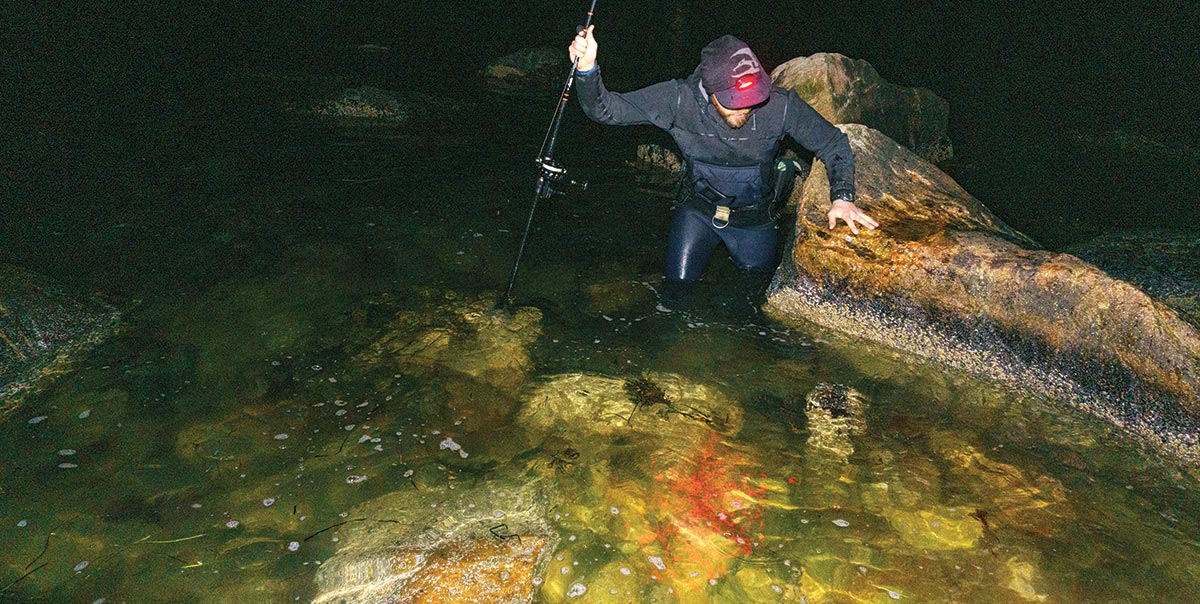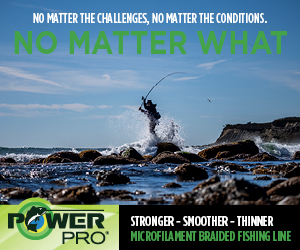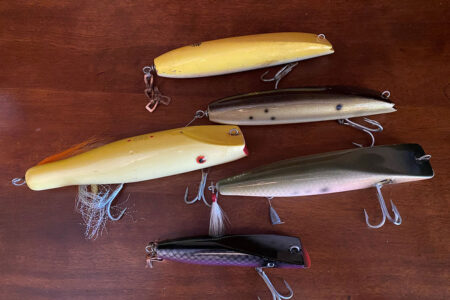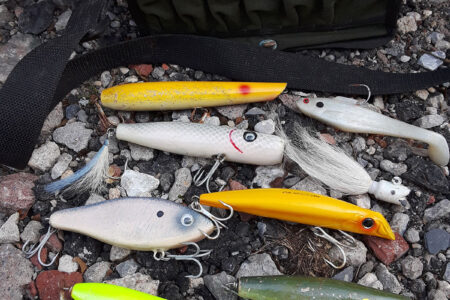
You don’t have to swim to appreciate the many benefits afforded by a wetsuit.
When I first talked with guys that used wetsuits in the surf, it was with anglers from fabled Montauk, NY. These guys were hardcore anglers that would swim long distances in their wetsuits to reach distant rocks. While it sounded like fun, I also found it extremely intimidating and thought these guys were pretty crazy. At the time, I simply couldn’t imagine swimming with my rod and plug bag; especially in the middle of the night. I also, frankly, didn’t see why it was necessary, and so didn’t buy a wetsuit for another entire season.
Then one night I was fishing a boulder field and was into a huge mass of schoolies. The action was crazy, even if the fish weren’t very big. However, I ended up slipping and falling off my boulder in the midst of a fish-every-cast blitz, tearing my waders from mid-thigh to the knee, giving myself a nasty bruise and filling the leg up instantly. I was amazed at how hard it was to wade back to dry land even with only one leg partially filled with water. But worse, without a back-up pair in the car, I was forced to leave the bite and will never know if I could have pulled out something larger from that massive school of fish.
That night, driving home and feeling quite frustrated, I thought, “Why not get a wetsuit?” Even though I barely had to wade past my knees, it would insure that I wouldn’t have to leave the bite due to torn waders ever again. I also could crawl on and off boulders more easily. That month I ordered my first cheap suit, and as they say, the rest is history. The first night I wore it, I count it as one of the biggest “ah-ha moments” I’ve ever had. Over subsequent weeks and months, I found I loved my suit for so many reasons, and it completely changed the way I fish. It, without question, increased the number of fish I caught every season. And while I do now swim occasionally, it is very rare. Instead, I have found so many other reasons to love a wetsuit that have nothing to do with the ability to swim to rocks hundreds of yards from shore. In fact, I feel silly for not having skipped right past the “wader phase” of my fishing, and right into the “wetsuit phase.” I now use my wetsuit roughly 70 to 80 percent of the nights I fish from May through November.
However, before I detail why you should be using a wetsuit, I want to address the elephant in the room. Yes, they are tight and form-fitting, and you might feel self-conscious. Besides the assumption that having a wetsuit only makes sense if you swim, I think this is the second most common reason fishermen and women won’t buy one. Yet, no one will be making smart remarks to you when you start telling them about all the fish you’ve been catching because you can walk further, fish rougher conditions, or fish longer because you’re more comfortable. Don’t worry about how you look; you aren’t a contestant on Americas Next Top Model, you’re just trying to catch more fish. Swallow your ego, suit up in the “seal suit” and I promise you won’t regret it. Here’s why!

Durability
If I was to prioritize the reasons I wear a wetsuit, the primary reason would likely simply be so that I won’t ruin my waders. The majority of the spots I fish with a wetsuit could definitely be accessed with waders if you are extremely careful. Many don’t require going much deeper than waist deep, don’t have any current, and often feature limited wind chop or ocean swell. In fact, late in the season (after mid-November) I’ll often fish these spots with waders instead of a wetsuit, because I get so cold in the suit. So why bother with the wetsuit at all then? Simply put, fishing these spots, and many spots like them, would be very frustrating and very expensive in waders. They are composed of rocky shorelines that are difficult to walk across even under the best-case scenarios, and it’s easy to trip and fall. If this happens, you are at high risk of tearing your waders on rocks or a boulder as you try to catch yourself. There is almost zero tolerance in some of these places. Rocks covered in barnacles and mussels that are knee-to-waist-deep are just waiting to shred your waders, and it often takes barely more than a slight rub against them to begin letting in water. Even with knee pads over the top of my waders, it’s just too high a risk.
Even more risky is when I have to climb onto or off of a boulder that’s taller than basically waist height. If I have to do this, I’m almost never going to wear waders. While it’s technically possible to do it without ripping your waders, if you fish a lot like I do, you’re eventually going to make a mistake and tear them. And, frankly, it’s not going to take long. I find that while getting on a boulder is one thing, getting off is the real challenge. It’s hard to slide down a rock without slicing some part of the wader, especially in the seat. As a result, I often try to hop off, which then results in a risk of twisting an ankle or falling and tearing my waders lower in the leg. It’s simply far more convenient to wear a wetsuit.
Safety
While increased durability may be the primary reason I wear a wetsuit, the most important reason is safety. Having a wetsuit lets you push out that last little bit which isn’t possible with waders, and this is in itself a reason to own one. There are several places I fish that require absolutely no swimming but do require a substantial distance of deep wading. These spots might be OK to fish with waders, particularly if you’re wearing a surf top and tightly-cinched surf belt. Yet, I’d be worried I’d step in a hole or trip and fill up my waders, and when I’m out fishing alone in the dark, I simply cannot accept “maybe safe.” Further, I like to fish a couple of these spots in the fall during Nor’easters and hurricanes when the water can get pretty rough. The chances of getting knocked down while wading out to a rock is relatively high. Getting knocked over with a wetsuit on is relatively harmless if you’re being careful; the same exact situation in waders can be very dangerous. Not only does the wetsuit provide a lot of buoyancy, there is simply no risk of it ripping and filling with water.
However, I think the place wetsuits are the most underutilized are in places with a lot of current or a risk of being pulled out to sea. For example, I fish a spot with substantial current that I never go past waist deep, yet I wear a wetsuit every night even if the wind and waves are calm. The current at this spot can be so strong at times that if I trip or stumble it’s easy to get swept off my feet. When this happens, I sometimes have to float along for a short distance before regaining my balance, and I have been tumbled and rolled as well. There are no big rocks or boulders, so this is no big deal in a wetsuit; it’s actually a little fun, and I often find myself laughing at the ridiculousness of the situation. However, in waders it would at best be frustrating, and at worst dangerous. Wearing a wetsuit simply eliminates a lot of the risk of a serious situation developing if swept off your feet.
Further, there is yet another area I fish that has strong current that I typically never go past shin deep, often barely getting my feet wet. This spot has a lot of current – a lot of current. If you fell in it would carry you out into the open ocean and there would be no way to swim against it, the current is just too strong. This situation would be extremely dangerous in waders, and I wear the wetsuit simply as a “just in case” even on the calmest nights. To this point, while I personally don’t fish breachways or inlets much anymore, I honestly don’t understand why more anglers don’t wear wetsuits on inlet jetties. I would argue inlets are one of the most dangerous places that exist, as the risk of slipping and falling in is relatively high and there is absolutely no way you’re swimming against the current. While PFDs are catching on, these to me are still a risk; you either have to inflate them yourself or trust they will inflate when you need them. I used to swim competitively and the thought of having to swim in my waders after being washed a mile or more out into the ocean, even with a PFD, is a daunting and scary thought. I’ll happily wear my wetsuit, thank you!
This same concept and logic applies to areas that are extremely rough or have lots of ledge; places like Newport, RI or many places in Maine. While you may never get wet, knowing that if you fall in you are buoyant and able to sustain a longer swim back to safety makes the inconvenience of suiting up each night worth it. You should never, ever be exceeding your limits, and I am not encouraging you to take any risks. However, under the above scenarios I simply wear the suit hoping I will never need it.
Finally, I prefer to wear my wetsuit during really rough nights in the fall on open sand beaches. Those nights that the swell is huge, and washing really far up the beach. With waders, you have to be hyper vigilant and stay back really far, ensuring you don’t get knocked down. While you certainly don’t want to get bowled over and tumbled in a huge surf like that – it would be extremely dangerous no matter what you’re wearing – you would more likely be able to get up and out of it in a wetsuit, than if you were wearing waders. The first rule is to never exceed your limits, and err on the side of caution, but the wetsuit provides another small layer of insurance that makes it worth wearing.

Comfort
Finally, I wear a wetsuit often because it is far more comfortable than waders. I know this is debatable for some of you, but I find the wetsuit simply more comfortable to be in on most nights. It’s probably because I do a lot of walking and wading, but regardless, I love wearing a wetsuit. Yet, there are some situations it is undeniable that the wetsuit is more comfortable, even if you hate wearing it. First and foremost, wetsuits are far more comfortable than waders when it’s hot out, even if you only have to walk short distances. The ability to roll down a wetsuit to your waist and walk with either just a rash guard on or no shirt at all is a huge benefit. It’s also very easy to cool yourself down by getting yourself wet. My friends and I often dunk ourselves completely under the water and fill our suits intentionally during those sweltering 90-plus-degree days. I can’t imagine wearing waders during those tides as the risk of heat exhaustion could be high!
Wetsuits are great if the air is hot, but the water is cold. In waders, you can get very sweaty walking to the spot you’d like to fish, but then be cold once you’re in the water. With a wetsuit, you can roll it down to stay cool, with your surf top tied around your waist. When you finally arrive at your destination, pulling the suit up and putting the top on over it is often more than enough to keep you warm when wading in 60-degree water.
Wetsuits are also my preferred outerwear when I have to make really long walks in the summer and fall. If you are someone who fishes the wide open beaches of the Cape or Long Island, and have to walk several miles in a single direction, I urge you to try a wetsuit. They are less cumbersome, and as I’ve stated above, they are easier to control your body temperature in. I also find I have less of a risk of chafing in a wetsuit when I wear the proper under garments during these walks. There are plenty of nights on these wide-open beaches that I’ll barely go in past my ankles, but the wetsuit is simply far more comfortable to walk in so I wear it.
Again, if you can get over the stigma of being judged or feeling like you look strange in a wetsuit, it can be a powerful tool in helping you land more fish. Being comfortable while fishing will keep you out there longer, and this is a huge factor in catching more fish these days. Sticking it out an entire tide is a lot easier to do when you’re comfortable and feel safe; and the wetsuit is the tool that makes this possible on many nights. No swimming required.




